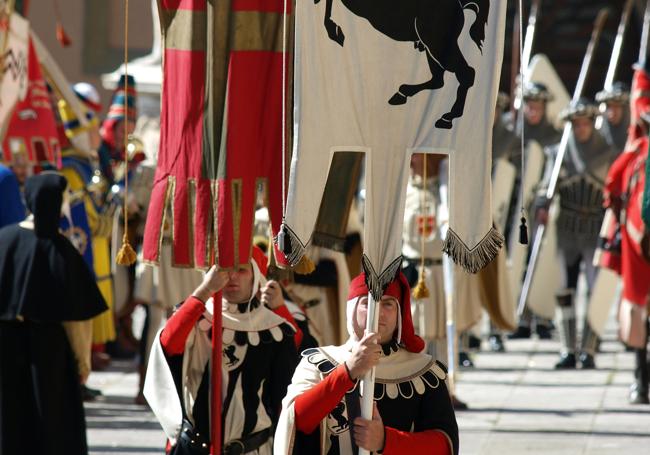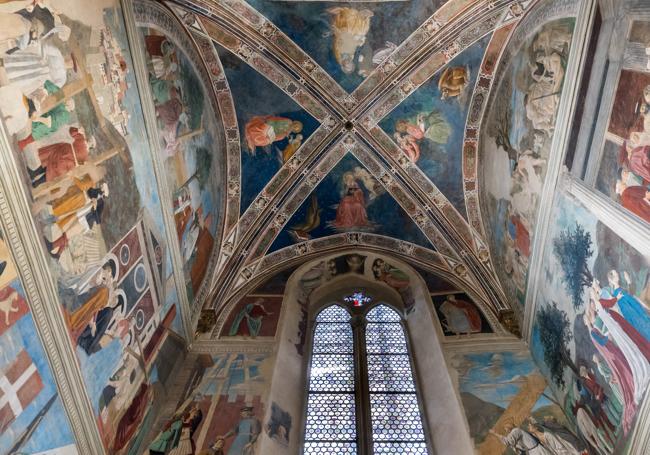Step back in time in Italy: Arezzo awaits
From jousting festivals to Renaissance frescoes, why this charming city is the perfect way to explore the best that Tuscany has to offer
Louise Montefiore
Malaga
Friday, 30 August 2024, 13:32
A jewel in the rolling hills of Tuscany, Arezzo is slightly off the typical tourist-beaten path. But, less than an hour by direct train from Florence, or about an hour by car, it is easy to access, offers unique cultural activities and is simply enchanting. No wonder it served as the setting for Benigni's 1997 film Life Is Beautiful.
Arezzo originated as Aritim, when it was one of the 12 most important Etruscan cities. Conquered by the Romans in 311 BC, Arretium, as it was then known, would grow to be the third largest city in Italy, particularly known for its red-clay pottery. Arezzo thrived throughout the Middle Ages, though it fell to Florence in 1384. Its rich art and architecture are a testament to its prestige through the years.
Arezzo suffered heavy damage during World War II before being liberated by British and New Zealand troops. Established in November 1944, the Arezzo War Cemetery was built to house the remains of Allied casualties. Despite the battle, the city's historic centre, which sits atop a steep hill, survived the ordeal and maintains its medieval features.
Long-standing traditions
Indeed, these remain the setting for the Saracen joust, which sees the city transported back to the Middles Ages, with people dressed up in medieval costume as each 'quarter' competes to win the Golden Lance. 'Knights' on horseback recreate this ancient game of chivalry and colourful processions are held throughout the city to mark the occasion. The tradition became typical in Arezzo in the 17th century and has appeared and disappeared since, before being firmly established in 1931. It takes place twice a year, in June and September, on and around Piazza Grande.

Also held on Piazza Grande, the city's main square, as well as on Piazza San Francesco and Logge Vasari, is Arezzo's famous Antiques Fair. Over 500 antiques dealers gather from across the country every month to sell all sorts of curated gems: from books and jewellery to furniture and art. Held since 1968 on the first Sunday of the month and the preceding Saturday, this is one of the city's main spectacles.
Cuisine: beauty in simplicity
On a regular day, Piazza Grande is still lively with terraces, a perfect spot for lunch or dinner. Arezzo's typical dishes are quintessential Tuscan cuisine: minimalist but made with high-quality, fresh local produce which will delight any foodie. One such example is 'crostini neri toscani', a classic Tuscan antipasto consisting of toasted bread topped with chicken liver pâté, typically enjoyed before a meal - and often accompanied by a glass of local wine. Chianti Colli Aretini DOCG, for instance, is a red wine made from grapes grown in Arezzo province.
The area is also known for its meats and cold cuts, with other typical dishes including 'bistecca alla fiorentina' (grilled beef steak), and 'panina', a traditional cake from Arezzo either enriched with bacon or made sweet with raisins and saffron. Of course, there are also excellent pasta options for your 'first course' and a selection of great cheeses, including the local Abbucciato Aretino, a pecorino made in the province.
A city of art
And for lovers of art, Arezzo is packed with sights, mainly housed in its churches. Its most famous are probably the magnificent frescoes on the chapel walls of the Basilica of San Francesco. Painted in the 15th century by Piero della Francesca, a key figure of the Early Renaissance, The Legend of the True Cross is considered to be one of the artist's greatest works. Arezzo's cathedral is also home to works by Piero, namely his fresco of the Magdalen. Just a few minutes north of here, the Basilica of San Domenico is also known for housing great artwork - in particular, Cimabue's famous painted Crucifix, from the 13th century. The church has even been recognised as a Unesco World Heritage Site.

The family home of artist Giorgio Vasari, the Vasari House Museum, also houses art painted on its very walls. The interiors are decorated with works by Vasari from the 16th century, one the best examples of the Mannerist style in Tuscany. More of his pieces, and other works from the Middle Ages to the 19th century, are on display at Arezzo's National Museum of Medieval and Modern Art in the Bruni Ciocchi palace.
The city also has a special place in music history. Guido d'Arezzo, a medieval monk, invented a new system of musical notation in 1025 which revolutionised the transmission of music in Europe. Prior to this, instead of being able to write music down, people relied heavily on oral imitation. Arezzo keeps its musical legacy alive via the Terre d'Arezzo Music Festival, a yearly celebration of classical music.
History buffs should not miss the city's Roman amphitheatre, which is part of the National Archaeological Museum Gaius Cilnius Maecenas, housed in the former monastery of St Bernard. The museum depicts Arezzo's history, from Etruscan times through to late antiquity. There are also rooms dedicated to prehistoric finds and the terra sigillata vases which made the city so prosperous in Roman times.
The Medici Fortress is another highlight and looks out over breathtaking panoramic views of Arezzo. And, whether or not you have attended the Antiques Fair, it is worth visiting the home of its founder, Ivan Bruschi. Located in the Palace of the Capitano del Popolo, one of Arezzo's most impressive Gothic buildings, the Ivan Bruschi Antiques House Museum is filled with curiosities.
Small towns nearby
It's no surprise that Arezzo is surrounded by other picturesque towns - this is Tuscany, after all. If you're a fan of Piero della Francesca, head to San Sepolcro and Monterchi, home to more of his art. Montepulciano is famous for its wine but also boasts incredible views and plenty of lovely squares, cafés and restaurants. For its Etruscan Academy Museum, visit Cortona, and for its castle, head to Poppi. Anghiari, Lucignano and Castiglion Fiorentino are also excellent options. Arezzo - and its surroundings - truly will spoil you for choice.
